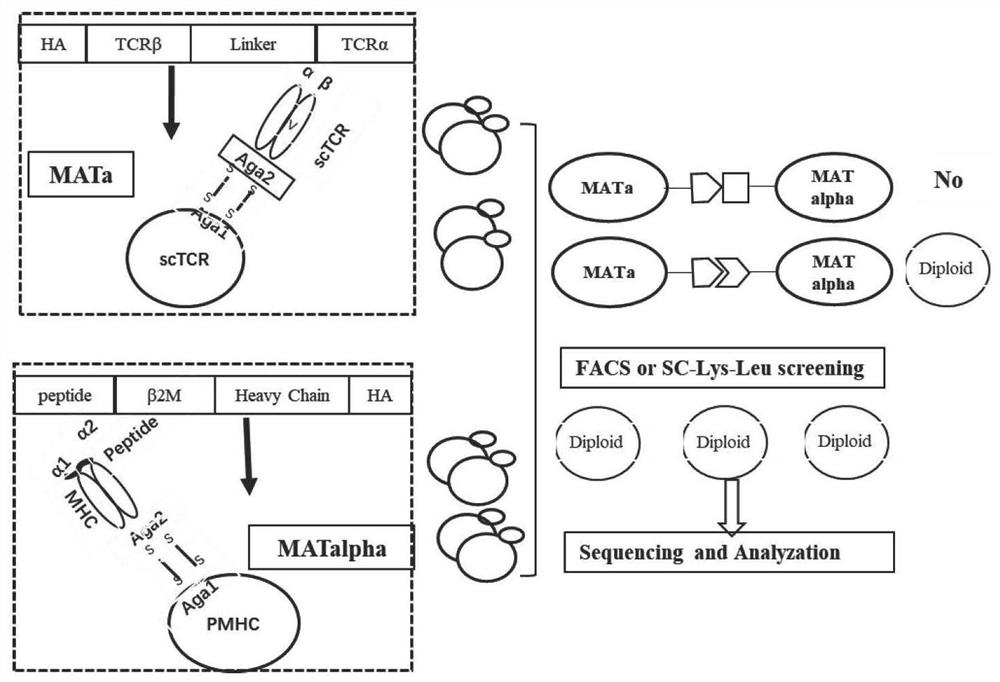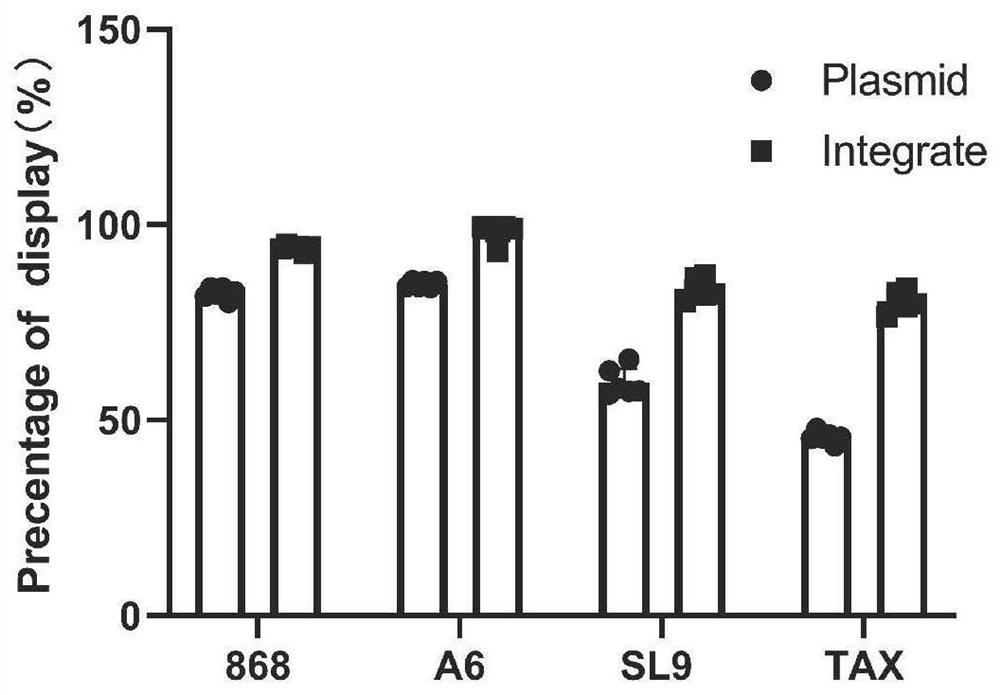A rapid method for identifying cross-reactive activity of high-affinity TCR antigens
A cross-reactive, high-affinity technology, applied in chemical instruments and methods, botanical equipment and methods, biochemical equipment and methods, etc., to avoid false positives, simplify the operation process, and demonstrate the effect of improving kurtosis
- Summary
- Abstract
- Description
- Claims
- Application Information
AI Technical Summary
Problems solved by technology
Method used
Image
Examples
Embodiment 1
[0067] This example mainly introduces a method for rapidly identifying the cross-reactivity of high-affinity TCR antigens.
[0068] as attached figure 1 As shown, a method for rapidly identifying high-affinity TCR antigen cross-reactivity, comprising the following steps:
[0069] S1. Adjust the TCR and pMHC sequences to constitutive promoters to induce expression, integrate and express the elements into the yeast genome, and display the TCR and pMHC proteins on the surface of yeast with different mating types;
[0070] S2. Yeast mating experiments using different mating-type yeasts integrating TCR and pMHC;
[0071] S3, diploid screening and next-generation sequencing.
[0072] Further, the step of S1 includes:
[0073] Firstly, construct the TCR sequence to be studied into scTCR form, and obtain the peptide mutation library of pMHC;
[0074] Transform the pMHC library to construct the required receiving vector ysynalpha_DEST, and obtain the vector of ysyna-TCR and ysynalp...
Embodiment 2
[0107] This embodiment is carried out on the basis of the above-mentioned embodiment 1, and the similarities with the above-mentioned embodiment 1 will not be repeated.
[0108] This example mainly introduces a specific implementation method of a method for rapidly identifying high-affinity TCR antigen cross-reactivity, including the following steps:
[0109] S1. Adjust the TCR and pMHC sequences to constitutive promoters to induce expression, integrate and express the elements into the yeast genome, and display the TCR and pMHC proteins on the surface of yeast with different mating types;
[0110] S2. Yeast mating experiments using different mating-type yeasts integrating TCR and pMHC;
[0111] S3, diploid screening and next-generation sequencing.
[0112] Further, the step of S1 includes:
[0113] Firstly, construct the TCR sequence to be studied into scTCR form, and obtain the peptide mutation library of pMHC;
[0114] Transform the pMHC library to construct the required...
Embodiment 3
[0149] This example mainly introduces the element design for the integrated expression of TCR and pMHC.
[0150] This embodiment is carried out on the basis of the above-mentioned embodiment 1, and the similarities with the above-mentioned embodiment 1 will not be repeated.
[0151] In the present study, the yeast surface display of TCR and pMHC utilized the α-lectin-target gene surface display system. α-lectin is composed of core subunit Aga1 and binding subunit Aga2, which are connected by disulfide bonds, and the C-terminus of core subunit Aga1 is covalently bound to cell wall glucan. TCR and pMHC are fused to the C-terminal or N-terminal of the Aga2 protein in yeast a-lectin, the expression of the fusion protein is induced by the GAL1 promoter, which is a galactose-inducible system, and the yeast grows in glucose medium When the transcription of the GAL1 promoter is completely inhibited, the Aga2p fusion gene product can be induced to produce the Aga2p fusion gene product...
PUM
 Login to View More
Login to View More Abstract
Description
Claims
Application Information
 Login to View More
Login to View More - R&D
- Intellectual Property
- Life Sciences
- Materials
- Tech Scout
- Unparalleled Data Quality
- Higher Quality Content
- 60% Fewer Hallucinations
Browse by: Latest US Patents, China's latest patents, Technical Efficacy Thesaurus, Application Domain, Technology Topic, Popular Technical Reports.
© 2025 PatSnap. All rights reserved.Legal|Privacy policy|Modern Slavery Act Transparency Statement|Sitemap|About US| Contact US: help@patsnap.com



